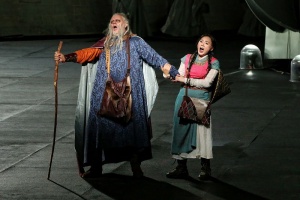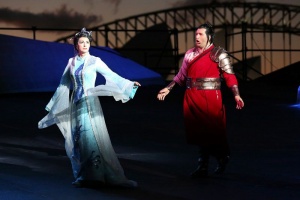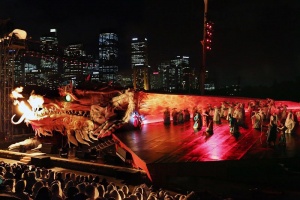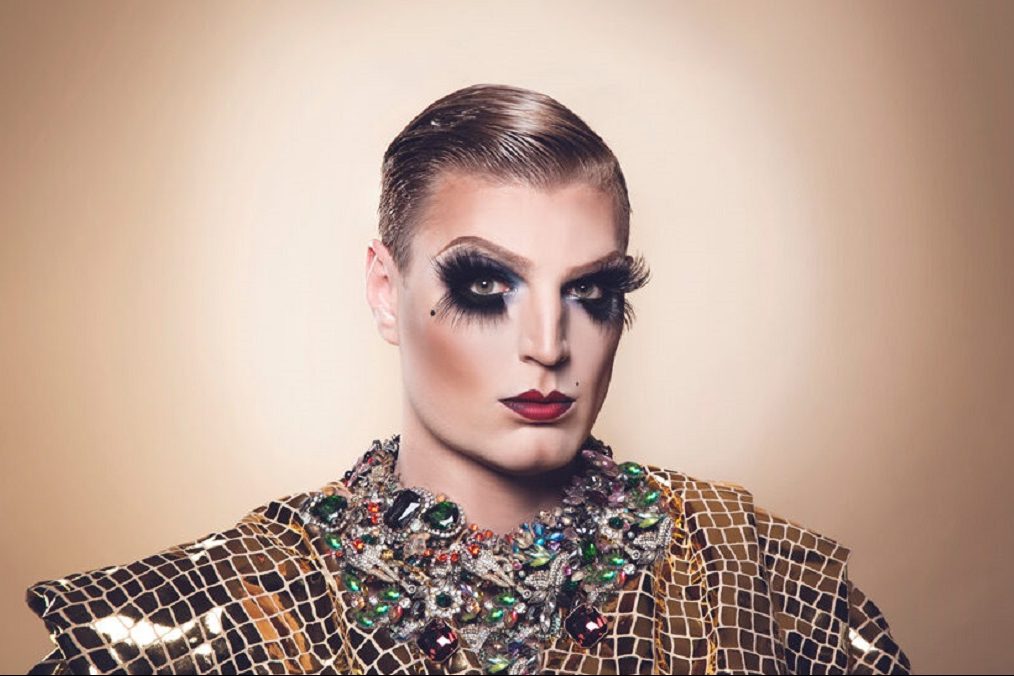WITH this harbourside production of “Turandot”, Opera Australia has surely reached the pinnacle of achievement for this kind of event.

Indeed it is the word ‘event’ that comes to mind even before the words ‘spectacle’ or ‘opera’. For with the magnificent setting, the balmy autumn weather, the Prime Ministerial and Vice-Regal presences and an excited crowd, nothing could go wrong.
True, the amplification of principals and the need to conceal the instrumentalists meant that musical perfection sometimes gives way to the exigencies of large-scale theatrical production and there were moments when the machinery was heard to creak, but it was a forgiving audience, out for a night of enjoyment.
In all, this is a most satisfying production. The sheer magnificence of Riccardo Massi playing the protagonist Calàf added a robust and full-bodied element to this role that made perfect sense of it. This is no mean achievement, for the problem with “Turandot” has always been in the libretto.
Put simply, it is well-nigh impossible to believe that a hardy Tartar prince would fall for the ice maiden Turandot so that he would lay down the lives of his family and the entire population of Beijing for her dubious love. And there’s the other problem —the princess who gives her name to the title of the opera is certainly not a central or vital character. A cardboard figure from mythology, she remains aloof and aloft for most of the evening, oblivious to the suffering around her and the moments in which she treads the earth are unconvincing.

Additionally with “Turandot” we can only guess how Puccini would have resolved these dramatic problems had he lived to complete the work. The constant recycling of musical motifs suggests that those who completed the opera had little idea either. This leads to the sense of this work as a mixture of high spectacle and Gilbert & Sullivan, for comedy is never far from tragedy, as the characters of Ping, Ping and Pang demonstrate.
Happily Puccini did achieve a partial solution with the introduction of the character Liù, sung and acted with superlative passion by soprano Hyeseoung Kwon in fine balance with Conal Coad as Calàf’s exiled father Timur. Her aria “Tu che di gel sei cinta” propels the drama forward and this domestic drama sits perfectly within the largest schematic framework of the opera. We have no feelings for the great Emperor whose long life is constantly being extolled by the chorus, but we do feel for the ageing king and the warm-blooded girl who looks after him.

The thankless title role of Turandot pales in comparison with these performances and the voice of soprano Dragana Radakovic in the role was not well-served by the amplification even in her aggressive opening aria “In questa reggia”.
China-born, New York based director Chen Shi-Zheng has well understood the need to make Liù, Timur and Calàf live and breathe, giving a credible centre to the opera. Additionally, his training in Chinese Opera ensures that he keeps the production within a ‘tradition’ Chinese framework while employing all the technology at his disposal. Conductor Brian Castles-Onion leads the orchestra and the magnificent chorus of Opera Australia to create a rich sound echoing around the harbour.

And so to the spectacle. Dan Potra’s set is dominated on one side by a fire breathing dragon which, given a good thump, flashes its eyes and belches smoke. The dragon’s body extends across the stage to create a backdrop for projected visions of classical China. As Calàf concludes the high notes of “Nessun Dorma” – which some people have come a long way to hear – fireworks explode briefly from behind the stage.
To stage left Potra has created a giant pagoda that opens to reveal the icy princess high above the audience. The Emperor is flown in by crane, a trick that goes right back to the theatre of Ancient Greece. If you’re not in the centre part of the seating, you might not see everything, but the several punters I spoke to declared themselves satisfied. The costumes, also designed by Potra, were colourful and historically researched, in keeping with the grand courtly spectacle required, but the wafting sleeve-dancers often got in the way of the drama.
“Turandot” is certainly the most difficult opera so far essayed by Handa Opera on Sydney Harbour and possibly the most spectacular. Opera Australia has set itself a mighty challenge to equal this in the future.
Who can be trusted?
In a world of spin and confusion, there’s never been a more important time to support independent journalism in Canberra.
If you trust our work online and want to enforce the power of independent voices, I invite you to make a small contribution.
Every dollar of support is invested back into our journalism to help keep citynews.com.au strong and free.
Thank you,
Ian Meikle, editor




Leave a Reply